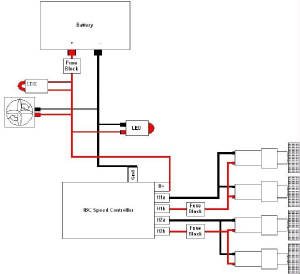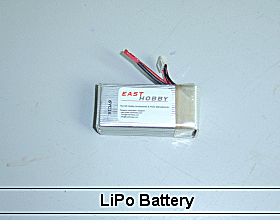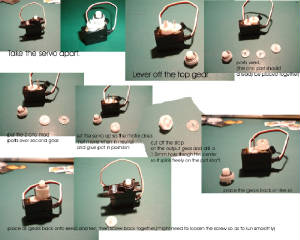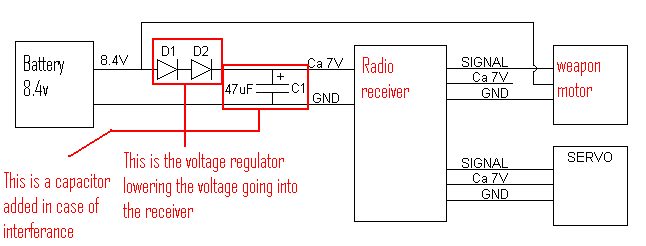|
Hell's Angel's control system:
This is a circuit diagram of Hell's Angels operating system. This diagram shows possible positions of fuses, which are
in place to avoid the speed controllers getting burnt out. the fuse bank nearest to the batteries is there to save the batteries
AND NOTHING ELSE, the fuses by the motors save the speed controllers.

OVER VOLTING A ROBOT:
Over-volting a motor will give a robot more speed and power than the motor will on its recomended voltage, however, the
motors/servos will get very hot if run for a long time, but since fights only last 3 mins, they should be ok, but don't over-do
it. There are some incidences where a higher voltage is required on one system but not on another, such as weapons systems
and drive systems. DBA, the AWS 18 champion, uses a voltage regulator that supplied the drive with 6v, the weapon with 11v,
and the receiver with 5v, thereby getting maximum power where they want it most.
Lithium Polymer Batteries
Lithium Polymer batteries, or 'Lipo's' are in common use in antweights because they can deliver a great deal of voltage
at about a 5th of the weight of a Nickle Metal Hydride (NiMh) battery of the same voltage. F.I.N's battery used to be a NiMH
weighing 25g, but his new Li-Po weights in at a measly 5g, but still delivers 6v of power. Li-Po's require special chargers
that need a 12v supply, not a mains voltage supply (220v). Below is a picture of a Li-po battery. Links to where to purchase
these are in the links section of this website

|
 |
|
|
|
 |
 |
|
F.I.N's drive servos:
F.I.N's drive servos have to be fast in order to make its weapon effective. F.I.N's servos are Naro HP/BB 9g servos,
but these servos are not speed modified in the conventional way with glue, but with a CNC'd polycarbonate part that slots
into the gear train and into the output gear, producing a lot of speed. Below is a set of pictures showing how F.I.N's drive
servos are modified, click for bigger picture.

VOLTAGE REGULATORS:
Voltage regulators are used in antweight robots to allow higher voltage to go to a weapons system and a lower voltage
go to the drive system, to avoid the drive system becoming overvolted and therefore getting overheated and burning out. Below
is a diagram of how a voltage regulator is set up to allow this to happen, and further down is a picture of the voltage regulator
used in F.I.N to allow power from the 7.4v Li-Po battery to come down to 6v:

Ni-Cad's and Ni-MH batteries:
Ni-Cad's (Nickle-Cadium) and Ni-MH's (Nickle Metal Hydride) are the best battery choice for featherweight and heavyweight
application in terms of power to weight, but care must be taken with them. For example, when the batteries have been in a
fight, they must be first discharged and then charged, and with certin chargeres this can be set so that it switches over
modes automatically. When you first get the batteries, they must be charged for a long time and at a certian amp rating, both
of which are stated on the batteries (Click above picture to see). After this initial charge, batteries can be charged at
different amp rating and for different times, depending on circumstance.
|
 |
|
|
|

